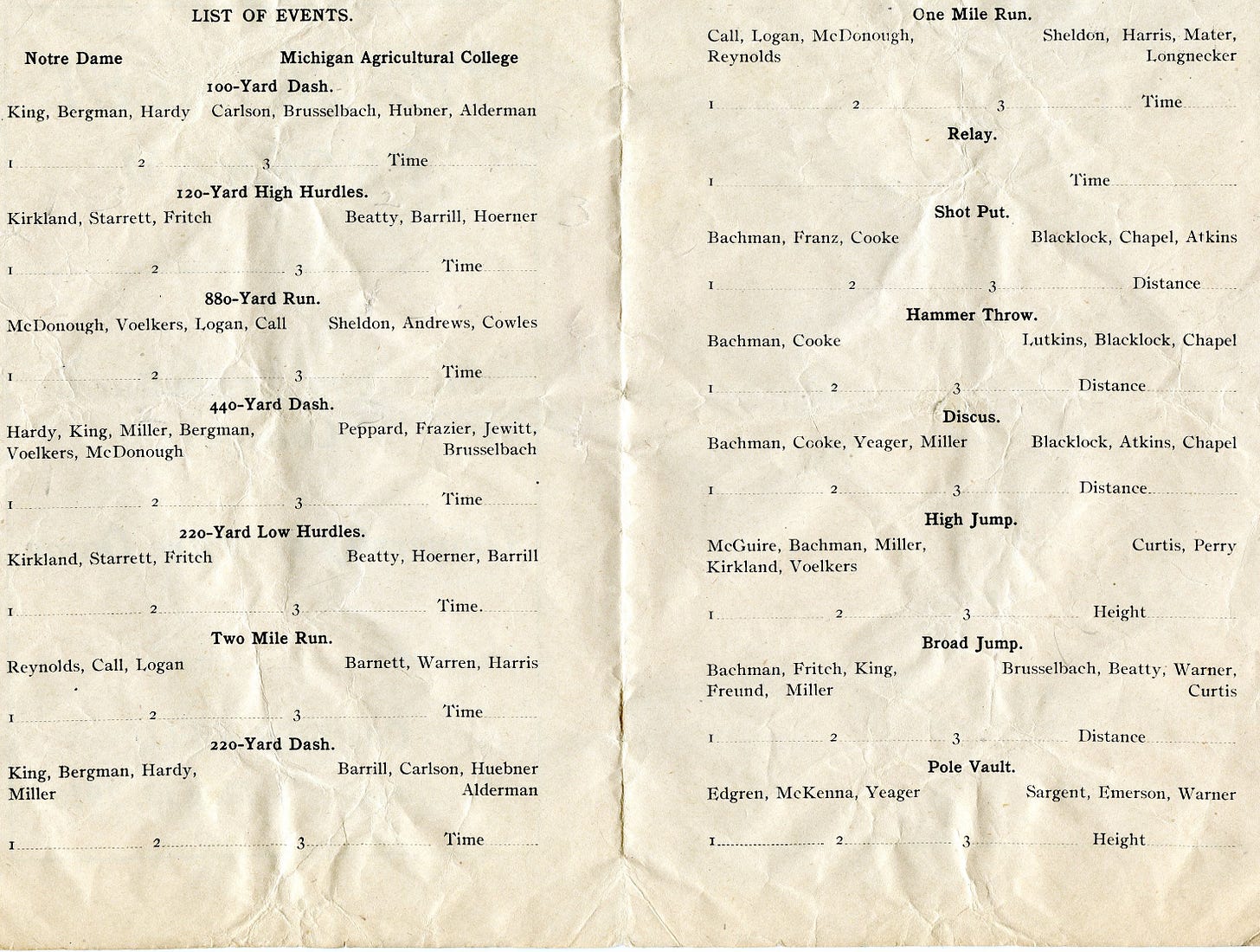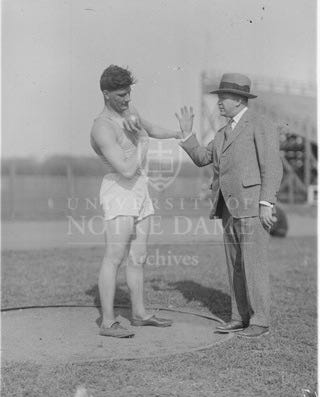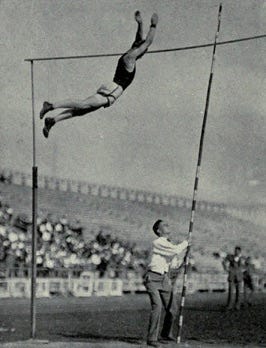Today's Tidbit... Knute Rockne, Notre Dame’s Famous Track Coach

As Notre Dame's head football coach from 1918 to 1930, Knute Rockne accumulated a 105-12-5 record during his 13 seasons at the helm. His 88.1 winning percentage is the highest all-time among major college coaches. Rockne's tenure as Notre Dame's head track coach is less well known, a position he also held for 13 years from 1914 through 1926.
Rockne entered Notre Dame as a 22-year-old, having worked four years as a postal worker after graduating from high school. He did not participate in athletics as a freshman because he worked numerous side jobs to pay his tuition and board while excelling in the classroom. Rockne excelled after joining the football team and famously was on the receivin’s passes that helped beat Army in 1913.
But Rockne also excelled on the track and more often in the field events, achieving team bests during his senior season with a 21 feet 5 1/2 inch broad jump and a 12 feet 4-inch pole vault that set a school record. (Pole vaulters used steel poles and landed in sawdust pits at the time.)
Upon graduating, Rockne married and planned to study medicine at St. Louis U. However, the medical school's unwillingness to let him coach football on the side led him to return to Notre Dame as a chemistry instructor, football line coach, and head track coach. (Think of what might have been had Rockne assisted and then taken over St. Louis U football rather than Notre Dame.)
Rockne continued as Notre Dame's track coach through the spring of 1927. The Notre Dame yearbook commentary describes Rockne's coaching style for track and field as different from his hard-charging taskmaster persona on the gridiron. He approached coaching track as a counselor, establishing individualized training plans for each athlete and inspiring them to work tirelessly.
Each year, the team had dual meets with Big Ten teams and competed in the Indiana Intercollegiate, Western Intercollegiate, Penn Relays, and Drake Relays. They were good enough to win many dual meets, were Indiana college champions annually, and did well in major meets. However, they lacked the depth of talent needed to win national-level competitions.
Still, Rockne's teams regularly produced top individuals in various events, and many of his track stars also played football. Charlie Bachman was an early star as one of the nation's top discus throwers and the AAU shot put champion. An offensive lineman, Bachman went on to coach Northwestern, Kansas State, Michigan State, and Florida.

Three of Rockne’s track athletes competed at the 1920 Olympics in Antwerp, with Gus Desch, a running back, earning the bronze in the 400-meter hurdles. Johnny Murphy was the AAU champion but placed 4th in the high jump, and Billy Hayes, their star sprinter, was injured and did not perform to standard.
Rockne's 1924 track team likely had its greatest collection of stars. Elmer Layden, who gained fame as one of the Four Horseman when they won the football national championship in 1924, set a school indoor record in the 40-yard dash, being timed at 4.4 seconds. Eugene Oberst, a right tackle on the 1924 team, one of the Seven Mules that blocked for the Four Horsemen, earned a bronze medal in the 1924 Paris Olympics in the javelin. And Tom Lieb, a football lineman a few years earlier but competing in track as a grad student, took bronze in the discus in Paris and set the world record several weeks later. Most important, Lieb introduced the spin technique to discus throwing, which remains standard today.

Winning the 1924 football national championship increased the demands on Rockne's time. He stepped down from the role after the 1926 season, so it was appropriate that the track team captain in Rockne’s final season was Paul Harrington, a pole vaulter who beat Rockne's school record and briefly held the national collegiate record at 13' 1 1/8."
Like many full-time college coaches from 1900 to 1940, Knute Rockne coached more than one sport. What makes him unusual, however, was continuing to coach track after becoming a national celebrity in the early 1920s and a national champion coach in 1924. He eventually gave up his side hustle, coaching football and directing the Irish athletic department for four years before his death in a plane crash in 1931 at 43 years old. The Rockne legend today focuses on his role with the dominant Irish football teams. Still, his track teams were also very solid, with individual stars that added to his legendary status.
Click here for options on how to support this site beyond a free subscription.



